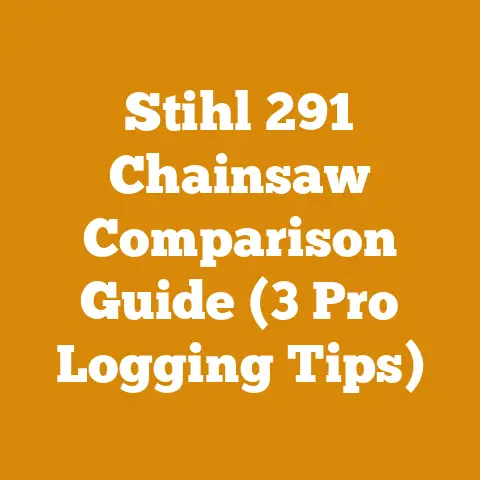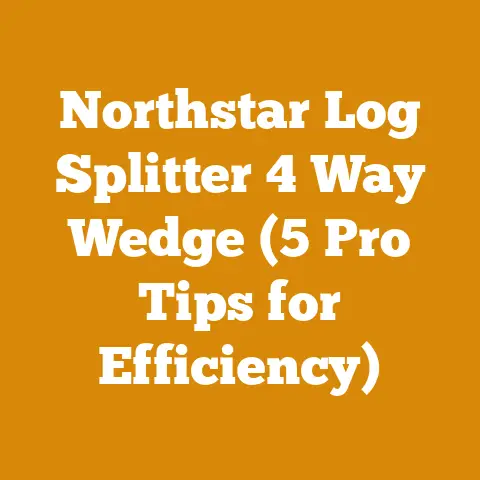Will Deer Eat Norway Spruce? (5 Proven Woodland Defense Tips)
The air is crisp, the leaves are turning, and the scent of woodsmoke is just around the corner. Autumn is here, and with it comes the annual ritual of preparing for winter. For many of us, that means stocking up on firewood. But for those of us with stands of Norway Spruce, it also means a crucial question: Will deer eat Norway Spruce? And if so, what can we do about it?
As someone who’s spent years felling trees, splitting logs, and wrestling with everything from stubborn chainsaws to even more stubborn wood, I’ve seen firsthand the damage deer can inflict. It’s not just about aesthetics; deer browsing can seriously impact the health and growth of your valuable trees. So, let’s delve into the deer dilemma and explore some proven woodland defense tips.
The State of Play: Wood, Deer, and the World
Before we get into the nitty-gritty, let’s take a quick look at the broader picture. Globally, the wood processing and firewood industry is a significant economic driver. According to a recent report by the Food and Agriculture Organization (FAO) of the United Nations, global roundwood production reached 3.9 billion cubic meters in 2022. A substantial portion of this goes toward firewood, especially in developing nations, but also in colder climates worldwide.
Meanwhile, deer populations are on the rise in many areas, leading to increased pressure on forests and woodlands. The US Forest Service estimates that deer browsing costs landowners millions of dollars annually in lost timber production and reforestation efforts. This creates a perfect storm for those of us trying to manage our woodlands sustainably.
Will Deer Eat Norway Spruce? The Unvarnished Truth
Okay, let’s get straight to the point: Yes, deer will eat Norway Spruce. While not their favorite food, especially when other, more palatable options are available, Norway Spruce becomes a tempting meal, particularly for young trees, when food sources are scarce, especially during the harsh winter months.
Think of it this way: deer are like us when we are hungry. They’ll prioritize a juicy steak, but if all that’s available is a slightly stale cracker, they’ll eat the cracker. In this analogy, a lush, tender white clover patch is the steak, and your Norway Spruce seedlings are the crackers.
Why Norway Spruce is Vulnerable
- Nutritional Value: While not exceptionally high in nutrients compared to other forage, Norway Spruce offers some sustenance, especially the tender new growth.
- Accessibility: Young saplings are easily accessible to deer, making them an easy target.
- Winter Desperation: During winter, when other food sources are buried under snow or have withered away, deer become less picky and more willing to browse on evergreens like Norway Spruce.
- Salt Attraction: Roadsides and areas treated with salt for de-icing can lead to salt accumulation in the soil, making Norway Spruce near these areas more attractive to deer.
My Personal Brush with Deer Damage
I remember one particularly harsh winter a few years back. I had recently planted a batch of Norway Spruce seedlings to help reforest a section of my property that had been cleared for firewood harvesting. I thought I had done everything right – good soil preparation, proper planting techniques, and plenty of sunlight. But come spring, I was devastated to find that nearly half of the seedlings had been heavily browsed by deer. The damage was significant, stunting their growth and leaving them vulnerable to disease. That’s when I knew I had to get serious about deer control.
5 Proven Woodland Defense Tips for Protecting Your Norway Spruce
After that experience, I researched and experimented with various methods to protect my trees. Here are five proven woodland defense tips that I’ve found to be effective:
1. Individual Tree Protection: The Barrier Method
This involves physically shielding each tree from deer browsing. It’s labor-intensive, especially for large plantings, but it’s highly effective, especially for young trees.
- Types of Barriers:
- Tree Shelters: These are plastic tubes that surround the seedling, creating a mini-greenhouse effect and protecting it from deer, rabbits, and other pests. They also help retain moisture and promote faster growth.
- Pros: Excellent protection, promotes growth, relatively easy to install.
- Cons: Can be expensive for large plantings, may require maintenance (e.g., removing debris), can become brittle in extreme weather.
- Wire Cages: These are made from wire mesh and provide a sturdy barrier against deer.
- Pros: Durable, relatively inexpensive, can be reused.
- Cons: Can be visually obtrusive, may require stakes for support, deer can sometimes reach over or through the mesh.
- Netting: Plastic netting draped over the tree can deter deer, but it’s less effective than tree shelters or wire cages.
- Pros: Inexpensive, easy to install.
- Cons: Less durable, can be damaged by wind or snow, deer can sometimes push through it.
- Tree Shelters: These are plastic tubes that surround the seedling, creating a mini-greenhouse effect and protecting it from deer, rabbits, and other pests. They also help retain moisture and promote faster growth.
- Installation:
- Choose the Right Size: Select a barrier that is tall enough to prevent deer from reaching the top of the tree. For most areas, a height of 4-6 feet is sufficient.
- Secure the Barrier: Ensure the barrier is securely anchored to the ground to prevent it from being knocked over by deer or wind. Use stakes or other fasteners as needed.
- Monitor Regularly: Check the barriers regularly for damage and make repairs as needed. Remove any debris that accumulates inside the barrier.
2. Repellents: The Scent-Sational Defense
Deer repellents work by deterring deer through unpleasant smells or tastes. They are a relatively inexpensive and easy-to-apply option, but they require regular reapplication, especially after rain or snow.
- Types of Repellents:
- Commercial Repellents: These are available in liquid, granular, or solid form and contain ingredients like putrescent egg solids, garlic, or capsaicin (the active ingredient in chili peppers).
- Pros: Readily available, easy to apply, often effective.
- Cons: Can be expensive, require frequent reapplication, effectiveness can vary depending on the product and deer pressure.
- Homemade Repellents: Some people have success with homemade repellents made from ingredients like soap, garlic, or hot pepper sauce.
- Pros: Inexpensive, can be made from readily available ingredients.
- Cons: Effectiveness can be inconsistent, may require experimentation to find the right formula.
- Commercial Repellents: These are available in liquid, granular, or solid form and contain ingredients like putrescent egg solids, garlic, or capsaicin (the active ingredient in chili peppers).
- Application:
- Choose the Right Repellent: Select a repellent that is specifically designed for deer and is appropriate for your climate and deer pressure.
- Apply Thoroughly: Apply the repellent to all parts of the tree that deer are likely to browse, including the needles, stems, and buds.
- Reapply Regularly: Reapply the repellent according to the manufacturer’s instructions, or more frequently if needed, especially after rain or snow.
- Rotate Repellents: Deer can become accustomed to certain repellents over time, so it’s a good idea to rotate between different types of repellents to maintain effectiveness.
3. Fencing: The Perimeter Protector
Fencing is one of the most effective ways to protect your Norway Spruce from deer, especially for larger plantings. However, it can be expensive and labor-intensive to install.
- Types of Fencing:
- Woven Wire Fencing: This is a sturdy and durable option that is effective at keeping deer out. A minimum height of 8 feet is recommended.
- Pros: Highly effective, long-lasting.
- Cons: Expensive, labor-intensive to install, can be visually obtrusive.
- Electric Fencing: This type of fencing delivers a mild electric shock to deer that touch it, deterring them from entering the enclosed area.
- Pros: Relatively inexpensive, easy to install, effective if properly maintained.
- Cons: Requires a power source, needs regular maintenance to ensure it’s working properly, can be ineffective in areas with heavy snow.
- Plastic Mesh Fencing: This is a lighter-weight and less expensive option than woven wire fencing, but it’s also less durable.
- Pros: Inexpensive, easy to install.
- Cons: Less durable, can be damaged by deer or wind, may not be effective in areas with high deer pressure.
- Woven Wire Fencing: This is a sturdy and durable option that is effective at keeping deer out. A minimum height of 8 feet is recommended.
- Installation:
- Plan the Fence Line: Determine the area you want to protect and plan the fence line accordingly.
- Install Posts: Install sturdy fence posts at regular intervals along the fence line. Use treated wood posts or metal posts for durability.
- Attach Fencing Material: Attach the fencing material to the posts, ensuring it is securely fastened and properly tensioned.
- Maintain the Fence: Regularly inspect the fence for damage and make repairs as needed. Keep vegetation clear of the fence line to prevent deer from jumping over it.
4. Habitat Management: The Ecosystem Approach
This involves manipulating the environment to make it less attractive to deer or to provide them with alternative food sources.
- Reduce Cover: Deer prefer areas with dense cover where they can hide from predators. Thinning out dense vegetation can make your property less attractive to deer.
- Create Open Areas: Deer are less likely to browse in open areas where they feel exposed. Creating clearings or meadows can discourage deer from entering your Norway Spruce planting.
- Plant Alternative Food Sources: Providing deer with alternative food sources, such as clover or alfalfa, can reduce their browsing pressure on your Norway Spruce.
- Encourage Predators: Predators like coyotes, wolves, and bobcats can help control deer populations. Protecting and enhancing habitat for these predators can be an effective long-term deer management strategy.
5. Noise Deterrents: The Sound of Silence (Broken)
Deer are easily startled by loud noises. Using noise deterrents can scare them away from your Norway Spruce.
- Motion-Activated Sprinklers: These devices detect movement and spray a burst of water, startling deer and deterring them from entering the area.
- Pros: Effective, relatively inexpensive, can also water your plants.
- Cons: Requires a water source, can be ineffective in cold weather when water freezes, may not be suitable for all locations.
- Ultrasonic Devices: These devices emit high-frequency sounds that are unpleasant to deer, deterring them from entering the area.
- Pros: Relatively inexpensive, easy to install.
- Cons: Effectiveness can be inconsistent, may not be effective in areas with high deer pressure, some people find the sounds annoying.
- Radios: Playing a radio in your Norway Spruce planting can deter deer by creating the impression that humans are present.
- Pros: Inexpensive, easy to implement.
- Cons: May not be effective in the long term, can be annoying to neighbors, requires a power source.
Case Study: My Spruce Survival Strategy
After my initial setback with deer browsing, I implemented a combination of these strategies. I started by installing tree shelters around the remaining seedlings. I also applied a commercial deer repellent regularly, especially after rain. I then added a low electric fence around the perimeter of the planting.
The results were dramatic. The tree shelters provided excellent protection from browsing, and the repellent and electric fence deterred deer from entering the area. Over the next few years, the Norway Spruce thrived, growing into healthy, vigorous trees.
Costs and Budgeting
Protecting your Norway Spruce from deer can involve significant costs, depending on the size of your planting and the methods you choose. Here’s a rough estimate of the costs involved:
- Tree Shelters: \$2-\$5 per tree
- Wire Cages: \$5-\$10 per tree
- Repellents: \$20-\$50 per application (depending on the size of the area)
- Woven Wire Fencing: \$5-\$10 per foot
- Electric Fencing: \$2-\$5 per foot
- Motion-Activated Sprinklers: \$30-\$50 per unit
- Ultrasonic Devices: \$20-\$40 per unit
When budgeting for deer control, consider the following:
- Prioritize Protection: Focus on protecting your most valuable trees first.
- Start Small: Begin with a small-scale project and expand as needed.
- Look for Discounts: Check with local nurseries and forestry organizations for discounts on tree shelters, fencing, and other supplies.
- Consider DIY Options: Homemade repellents and DIY fencing can save you money.
Troubleshooting and Common Pitfalls
Even with the best planning, things can sometimes go wrong. Here are some common pitfalls to avoid:
- Inadequate Protection: Make sure your protection methods are adequate for the level of deer pressure in your area.
- Lack of Maintenance: Regularly inspect and maintain your protection measures to ensure they are working properly.
- Ignoring Other Pests: Deer aren’t the only pests that can damage your Norway Spruce. Be aware of other potential problems, such as rabbits, voles, and insects.
- Giving Up Too Soon: Deer control is an ongoing process. Don’t give up if you don’t see results immediately.
Next Steps and Additional Resources
Protecting your Norway Spruce from deer is an investment in the future of your woodland. By implementing these proven woodland defense tips, you can ensure that your trees thrive and provide you with years of enjoyment.
Here are some additional resources to help you get started:
- Your Local Extension Office: Your local extension office can provide you with information on deer management and other forestry topics.
- State Forestry Agencies: State forestry agencies offer a variety of programs and services to help landowners manage their woodlands.
- Nurseries and Forestry Suppliers: Local nurseries and forestry suppliers can provide you with the supplies you need to protect your Norway Spruce from deer.
- Online Forums and Communities: Online forums and communities are a great place to connect with other woodland owners and share tips and advice.
Suppliers of Logging Tools and Drying Equipment:
- Baileys: (www.baileysonline.com) – Chainsaws, logging tools, and safety equipment.
- Northern Tool + Equipment: (www.northerntool.com) – A wide range of tools and equipment for wood processing and outdoor projects.
- Woodland Mills: (www.woodlandmills.com) – Portable sawmills and wood processing equipment.
Remember, every woodland is unique, and what works for one person may not work for another. Experiment with different methods and find what works best for you. With a little effort and persistence, you can protect your Norway Spruce from deer and enjoy the beauty and benefits of a healthy woodland for years to come. And who knows, maybe one day, you’ll be sharing your own tales of triumph over the deer dilemma!






